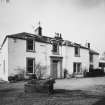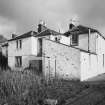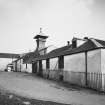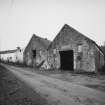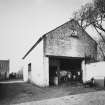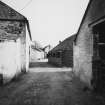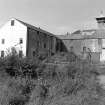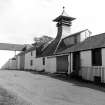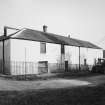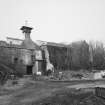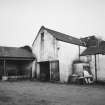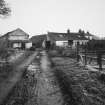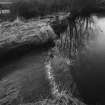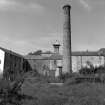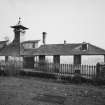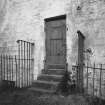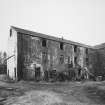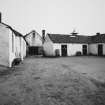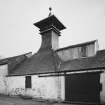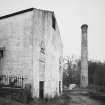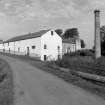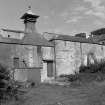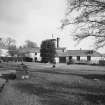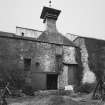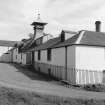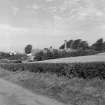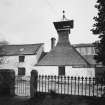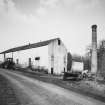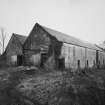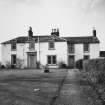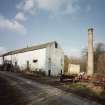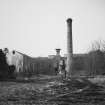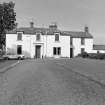Annandale Distillery
Distillery (19th Century), Farmhouse (19th Century), Farmstead (19th Century)
Site Name Annandale Distillery
Classification Distillery (19th Century), Farmhouse (19th Century), Farmstead (19th Century)
Alternative Name(s) Distillery Farm, Z-plan Former Distillery Range; Distillery Cottage
Canmore ID 66495
Site Number NY16NE 44
NGR NY 19450 68261
NGR Description Centred NY 19450 68261
Datum OSGB36 - NGR
Permalink http://canmore.org.uk/site/66495
- Council Dumfries And Galloway
- Parish Annan
- Former Region Dumfries And Galloway
- Former District Annandale And Eskdale
- Former County Dumfries-shire
NY16NE 44.00 centred 19450 68261
NY16NE 44.01 NY 1999 6813 Mill Dam (Northfield Burn)
NY16NE 44.02 NY 19471 68252 Chimney Stack
(Location cited as NY 194 683). Annandale distillery, founded 1830 by George Donald and rebuilt 1883 by J S Gardner. Now disused, but remarkably well preserved, with a 3-storey main range on an L plan, incorporating maltings and pyramidal-roofed kiln. The complex is completed by a 2-bay range of bonded stores, and a free-standing circular brick chimney. At the rear are the proprieter's house and a farm which operated in connection with the distillery.
J R Hume 1976.
Field Visit (October 2009 - February 2010)
NY 194 682 A short study of the distillery buildings undertaken in collaboration with Professor David Thomson in October 2009 was followed by a further programme of archaeological works from November 2009–February 2010. This work included a desk-based assessment, topographic and standing building surveys of the site, trial trench evaluation of the mash house and excavation of the eastern exterior of the main distillery range. The work highlighted the extent to which individual ownership played a key role in the form and development of the distillery through time.
Archive: RCAHMS (intended). Report: Dumfries and Galloway SMR and RCAHMS
Funder: Annandale Distillery Company Ltd
John Atkinson, Alastair Becket and Ingrid Shearer – GUARD
Publication Account (15 February 2021)
‘Proprietors, J.S. Gardner and Son…Annandale, from whence the distillery takes its name, is really the valley of the River Annan commonly called the How of Annandale.and one of the most garden-like distilleries in Scotland…private carriageway crossing a bridge over the Annan Burn and found ourselves at the gates of the works.
The distillery is a short distance from the Annan and is picturesquely situated, being embosomed with trees. It is built in a solid square, with a small central court and entered by a pair of sliding gates. The firm derives its water for distilling purposes from the Middleby Burn, high amongst the hills, which is the property of the town on Annan, but the water used for driving the turbine wheel etc. comes from a swiftly flowing stream situated above the works.
The distillery was formerly in the occupation of Mr George Donald, an excise officer who built it in the year 1830, and resided there for 40 years [1870].In 1883, Mr J S Gardner of Liverpool , leased the property and cleared the buildings of the old fashioned machinery and then re-arranged the whole place , putting in plant and all modern appliances used in distilling.
Mr Gardner is the son of a former Mayor of Liverpool. At his father’s death he retired from business with ample means….quite a model farmstead (higher up the slopes from the distillery) with cowsheds, piggeries, stables and ranged around a shed…pigs…fed…draff from distillery…. The malt is raised by elevator to the kiln at the end of the malting which is floored with wire cloth and heated with peat we next ascended a stair to the top storey of the adjoining building which forms the Mill Room, and contains a pair of malt rollers under which is the Grist Loft a floor some 5 feet above the level of the Mash Tun in the adjoining house ensuite to the mashing department we passed two copper heating tanks with open furnaces facing the yard. A…or enclosed wooden trough conveys the pulverised malt into the Mash Tun, a circular iron vessel holding 3,200 gallons. The house in which it is place d is spacious, well-lighted and of superior construction. The Worts are drained from he Tun and the liquid is pumped into the Worts Reservoir.
The Underback is usual placed on the ground floor of this building. The Distillery proper is a large house arranged on three terraces or slopes on the side of the hill, all under one roof. The top terrace is devoted to the Washbacks, new vessels four in number each containing 3600 gallons... On the next terrace is the wash changer a fine vessel holding 2 800 gallons, also the various receivers etc. and on the lowest floor are the Stills…all of the old pot kind.
In the Still House is placed the Safe, where the...safe is exposed in a glass case, kept locked by the Excise and under certain conditions it can be tested. The spirit flows through the safe into the Receiver in the Still House and from thence it is pumped to the spirit vat in the Spirit Store.
We noticed three old-fashioned spirit worm tubs outside the Still House. And adjoining the latter building is a engine house, wherein there is a capital 12 hp engine to supplement the water power if necessary. Opposite the Distillery over the stream are two bonded warehouses. The whisky is pure Malt and the annual output is 28,000 gallons.’
Barnard (1887)














































